Coin Rarities & Related Topics: News and Analysis regarding scarce coins, coin markets, and the coin collecting community #241
A Weekly CoinWeek Column by Greg Reynolds
Liberty Eagles were minted from 1838 to 1907. There are three types or subtypes. Gobrecht, also called ‘Head of 1838,’ Eagles were produced during just two years, 1838 and 1839. ‘No Motto’ Eagles date from 1839 to 1866 and ‘With Motto’ Eagles were minted from 1866 to 1907. Although ‘With Motto’ Eagles are much more common, in total, than the other two types, many dates are truly rare and are available for less than $5000 each. Indeed, some extremely rare dates may be found for less than $5000!
While the term ‘rare’ is often used in a loose or vague manner, I consistently define rarity in specific terms. A coin issue is rare if less than 500 are known in the present, including all varieties of the same date (and Mint location). If fewer than 250 are known, then a coin is very rare. A coin is extremely rare if less than 100 are known to exist. If fewer than twenty-five are known, then a coin may be a Great Rarity. The only Great Rarity in the series of ‘With Motto’ Liberty Eagles is the 1875 Philadelphia Mint issue, though the 1870 Carson City Mint Eagle may be more famous.
I. Collecting Strategy
Some background information regarding Eagles and other gold coins of the 19th century is found in part 4 on ‘No Motto’ Eagles. (Clickable links are in blue.) Although current “American Eagle” gold bullion items are called coins, collectors think of U.S. $10 gold coins that were minted from 1795 to 1933 as true Eagles.
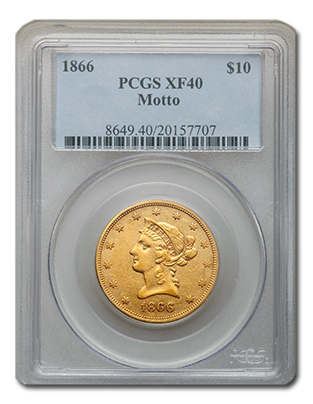 During 1866, the motto, “In God We Trust,” was added to the reverse (back) design of quarters, half dollars, silver dollars, Half Eagles ($5 gold coins), Eagles and Double Eagles ($20 coins). ‘No Motto’ Eagles and ‘With Motto’ Eagles have the same obverse (front) design.
During 1866, the motto, “In God We Trust,” was added to the reverse (back) design of quarters, half dollars, silver dollars, Half Eagles ($5 gold coins), Eagles and Double Eagles ($20 coins). ‘No Motto’ Eagles and ‘With Motto’ Eagles have the same obverse (front) design.
Most Liberty Eagles minted after 1879 are not rare and are easily obtainable. There is no challenge involved in obtaining just one post-1879 Liberty Eagle as a type coin. It would be more interesting, from the perspective of a collector building a type set, to obtain a truly rare ‘With Motto’ Eagle. Indeed, many collectors are enthusiastic about rarities.
Coins that are extremely common do not have the status in the coin collecting community as coins of the same respective design type that are truly rare. There are more than 150,000 1901-S Eagles around. Rare ‘With Motto’ Eagles are much more significant in the culture of coin collecting, while common ‘With Motto’ Eagles are often sold by telemarketing firms to buyers who know little about coins.
It is suggested that ‘type coin’ collectors buy rarities rather than typical, non-rare ‘type coins’ to represent design types in collections. Moreover, an alternative to collecting rarities or to building a typical type set is to assembly an extended type set of ‘Eagles with representatives of the various U.S. Mints that issued them. ‘With Motto’ Eagles were minted in Philadelphia, New Orleans, San Francisco, Denver, and Carson City (NV). Of course, such extended type collecting, which may include truly rare coins, is less difficult than assembling an entire set of Liberty Eagles ‘by date’ (and U.S. Mint location).
II. Philadelphia Mint Eagles
With the exception of the 1874, pre-1878 Philadelphia Mint, ‘With Motto’ Eagles are rare. Even the 1874 is very scarce, fewer than 1000 are known. In contrast, David Hall, the primary founder of PCGS, suggests that some 200,000 1901 San Francisco Mint Eagles “still exist.” Plus, I suggest that there are more than 100,000 1901 Philadelphia Mint Eagles around.
It is not practical to discuss herein all of the Philadelphia Mint Eagles dating from 1866 to 1877. The 1866 is a little more significant as it is the first year of issue of the ‘With Motto’ design type. Traditionally, there have been more than a few collectors who prefer coins of the first issue of respective design types.
There are probably fewer than 100 1866 Philadelphia Mint Eagles in existence, certainly not more than 135. Although PCGS and NGC together have graded nearly 100 1866 Eagles, this total includes multiple counts of many of the same coins and probably amounts to sixty different 1866 Eagles.
There are probably another twenty-five that have failed to receive numerical grades from either PCGS or NGC, though both services are fairly liberal in terms of judging rare Liberty Head gold coins as gradable. In hundreds of cases, a coin that had no chance of receiving a numerical grade from PCGS or NGC in the 1990s may now easily be assigned a numerical grade.
Additionally, there may be as many as ten 1866 Eagles that have never been submitted to PCGS or NGC. A fair estimate of the total number surviving is 95, though I would not be surprised if 110 exist. So, this issue is extremely rare or almost so; it is clearly very rare.
Since Dec. 2011, Heritage has auctioned three different, PCGS graded EF-40 1866 Eagles. The one that sold in Dec. 2011, in a relatively minor auction, brought $4887.50. At the winter 2012 FUN auction, another brought $3220. In Oct. 2012, Heritage auctioned a third PCGS graded EF-40 1866 for $4112.50.
More recently, in Jan. 2014, an NGC graded EF-40 1866 was auctioned by Heritage for $2585. In Dec. 2013, an NGC graded VF-25 1866 brought $1645. Even if this “VF-25” coin has some problems, and I am not implying that it does, this $1645 result seems reasonable from a logical perspective, for a very rare to extremely rare 19th century U.S. gold coin that is the first year of a design type. Further, online images make clear that this specific coin has considerable detail; it does not appear all that worn. Indeed, it seems sharper than the PCGS graded VF-30 1866 that Heritage auctioned in Jan. 2012 for $2070.
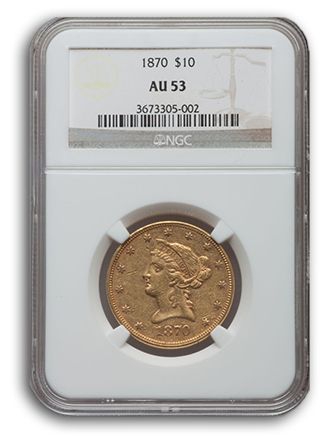 The 1870 is not as rare as the 1866. It is, though, very rare; there are certainly fewer than 250 in existence, very likely less than 150. An estimate of 130 in total seems logical. Also, there may be zero uncirculated (strict ‘Mint State’) 1870 Eagles.
The 1870 is not as rare as the 1866. It is, though, very rare; there are certainly fewer than 250 in existence, very likely less than 150. An estimate of 130 in total seems logical. Also, there may be zero uncirculated (strict ‘Mint State’) 1870 Eagles.
As for the lone NGC graded “MS-60” 1870, I would have to see it in actuality before I would consider believing that it is truly uncirculated. Researchers now doubt that a strict uncirculated 1870 Eagle survives.
I examined the PCGS graded AU-55 1870 that Stack’s-Bowers auctioned in New York in Feb. 2014. It is one of the highest graded and is likely to be superior to some of the other 1870 Eagles that are also PCGS or NGC graded as AU-55. It brought $4700.
Curiously, when the catalogue description for this coin was written, possibly in Dec. 2013, PCGS had graded eight 1870 Eagles as AU-55. Current data indicates that PCGS has graded eleven as AU-55. This is further evidence of my oft-repeated point that many of the same coins are submitted over and over again. This is a very rare coin and the vast majority of survivors grade below AU-50, if gradable at all. Three AU-55 grade pieces were not newly discovered in 2014.
In any event, the AU-55 grade 1870 that Stack’s-Bowers auctioned this year is an appealing piece, much better than I expected. Although it has been extensively, moderately cleaned and lightly dipped, this coin has naturally retoned to a significant extent and does not have any serious problems. The fields are a nice light orange-russet-tan and Miss Liberty’s hair is sort of a light russet-tan color. Further, there are some mellow green tints in the inner fields. The numerous hairlines are not upsetting. Overall, this coin is very attractive for a certified AU-55 grade gold coin from 1870.
In April 2014, Heritage auctioned an NGC graded AU-53 1870 for $3290. In Jan. 2012, a different NGC graded AU-53 1870 sold for $3450.
Eagles of this date have recently been available for less than $3000. In Oct. 2011, Heritage auctioned a PCGS graded AU-50 1870 for $2300. In July 2012, Heritage sold a PCGS graded EF-45 coin for $2530.
In Feb. 2014, Christopher Bently’s, NGC graded, EF-45 1870 realized $1880. A different 1870 Eagle, with the same certification, sold for $1840 in Feb. 2012.
The cited auction records of 1866 and 1870 Eagles are examples relating to an overall point that many truly rare, Philadelphia Mint ‘With Motto’ Eagles of several different dates can be found for less than $5000 each. A few of these dates are extremely rare.
III. New Orleans Mint
Liberty Head, ‘With Motto’ Eagles were not minted in New Orleans until 1879 and 1879-O Eagles cannot be easily found for less than $5000 each. Eagles dated 1880-O, 1881-O and 1882-O are rare, though are not extremely rare. Fewer than 500 of each survive.
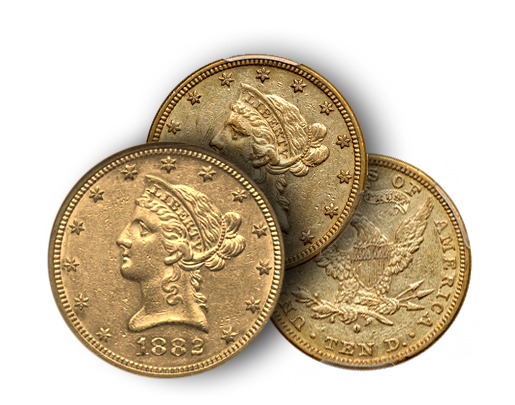 The 1880-O is probably very rare, perhaps around 220 survive. In Jan. 2014, Heritage auctioned a PCGS graded AU-50 1880-O for $3965.63.
The 1880-O is probably very rare, perhaps around 220 survive. In Jan. 2014, Heritage auctioned a PCGS graded AU-50 1880-O for $3965.63.
The 1881-O is not as rare as the 1880-O, though is likely to be very rare. Perhaps 230 to 255 survive? In June, the Goldbergs auctioned a PCGS graded AU-55 1881-O for $3525.
As for the 1882-O, maybe 285 to 335 survive. In Jan. 2013, Heritage auctioned an NGC graded AU-55 1882-O for $2467.50. In May of this year, the firm of “Great Collections” sold an NGC graded AU-50 1882-O for $1543.30.
The 1883-O is extremely rare and very famous. It is unlikely, though possible, that one could be found for less than $5000. The later, New Orleans Mint Liberty Eagles are not rare, though the 1906-O is very scarce.
IV. San Francisco Mint
There are many San Francisco Mint, ‘With Motto’ Eagles that trade for less than $5000 each. It is not practical to list many of them.
The 1866-S ‘With Motto,’ which should not be confused with the 1866-S ‘No Motto,’ is extremely rare and reasonably priced, considering that maybe fifty-five are known. In 2012, Heritage auctioned a PCGS graded VF-35 1866-S ‘With Motto’ for $3818.75.
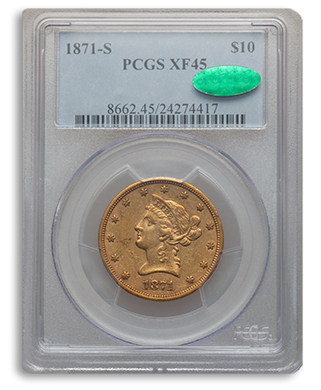 The 1868-S is very rare, maybe extremely so. Surely, there could not be more than 120 around. In March 2014, Heritage auctioned an NGC graded AU-55 1868-S for $4112.50. Two years earlier, Stack’s-Bowers auctioned a PCGS graded AU-53 1868-S for $3335.
The 1868-S is very rare, maybe extremely so. Surely, there could not be more than 120 around. In March 2014, Heritage auctioned an NGC graded AU-55 1868-S for $4112.50. Two years earlier, Stack’s-Bowers auctioned a PCGS graded AU-53 1868-S for $3335.
The 1871-S is probably about as rare as the 1868-S. Again, 120 is a fair estimate. In Jan. 2013, a PCGS graded EF-45 1871-S, with a CAC sticker, sold for $2608.50. In Feb. 2012, this exact same coin, in a different PCGS EF-45 holder, without a CAC sticker, brought $2415.
In June of this year, Heritage auctioned an NGC graded EF-40 1871-S, with a CAC sticker, for $1997.50. Generally, circulated gold coins with CAC stickers are far less likely to have been doctored than those that fail to receive CAC stickers. Frequently, coin doctors add gold-colored putty or other additives to cover contact marks and scratches, or just to make such imperfections less noticeable.
V. Carson City Mint
Eagles were minted in Carson City, Nevada, from 1870 to 1893, though not during every year. The CC dates in the 1870s tend to be extremely rare and expensive.
The 1880-CC is truly rare and is not particularly expensive. During the winter of 2012, Stack’s-Bowers auctioned an NGC graded AU-55 1880-CC for $2990 and a PCGS graded AU-50 1880-CC for $3450. Also, in Nov. 2012, Stack’s-Bowers auctioned a non-gradable 1880-CC, in a PCGS ‘Genuine’ holder, with AU grade “details,” for $1008.15
The 1881-CC is probably rare, though it might not be so. The 1882-CC is definitely rare. There are fewer than 500 in existence, probably less than 335. Certified, EF-40 to AU-53 grade 1882-CC Eagles tend to sell at auction for around $2000 to $4600 each. Coins competitively sought by ‘crack-out artists’ for possible upgrades have brought more than $4600. Also, a relatively original or especially lustrous 1882-CC may be worth a substantial premium over a coin that is ‘average’ for its respective certified grade, as most 1882-CC Eagles are not wonderful.
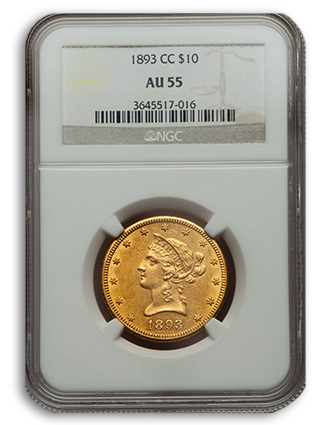 Though rare, the 1883-CC and the 1884-CC are each not as rare as the 1882-CC. There are dozens of PCGS or NGC graded 1883-CC Eagles that would, if consigned, sell for amounts between $2000 and $4500 at auction.
Though rare, the 1883-CC and the 1884-CC are each not as rare as the 1882-CC. There are dozens of PCGS or NGC graded 1883-CC Eagles that would, if consigned, sell for amounts between $2000 and $4500 at auction.
For the 1884-CC, the “271” number on PCGS CoinFacts is an underestimate. There must be more than 300 around.
In June 2013, Stack’s-Bowers auctioned a PCGS graded EF-45 1884-CC for $2117.35. In Jan. 2014, Heritage auctioned Donald Bently’s 1884-CC, which is NGC graded AU-50. It brought $2937.50. More recently, in July, an NGC graded EF-45 1884-CC sold for $2291.25.
There are no CC Mint Eagles dating from 1885 to 1889. At least, I have never seen one. The 1890-CC, 1891-CC and 1892-CC are each not rare, though are scarce.
The final Carson City Eagle, the 1893-CC, is rare. There are certainly fewer than 500 survivors, probably less than 300.
In June 2013, Stack’s-Bowers auctioned a PCGS graded AU-55 1893-CC for $4993.75. In April 2014, Heritage sold an NGC graded EF-45 1893-CC for $1762.50.
Finding one rare CC Eagle for less than $5000 is easy. Completing a set for less than $5000 each is theoretically possible, if non-gradable coins are admitted, though would be very difficult. It would not make sense to even attempt to complete a whole set of Liberty Eagles ‘by date’ (and U.S. Mint location) for less than $5000 coin.
The concept of an extended type set that features true rarities rather than standard ‘type coins,’ and includes representatives of all pertinent U.S. Mints, is novel, practical and interesting. Truly rare, PCGS or NGC graded, 19th century gold coins priced at less than $5000 each seem to be better values than many other classic U.S. coins, some of which are very common.
©2014 Greg Reynolds




